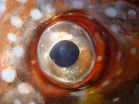Researchers discover new ways to shut down signals involved in brain diseases
2015-05-15
(Press-News.org) A research team based at the University of Eastern Finland and the Turku Centre for Biotechnology have found new ways to block a pathway that may be responsible for several brain disorders, which could open the door to developing better treatments.
The protein NOS-1 generates nitric oxide, a chemical signal that is linked to neurological disorders from neurodegeneration, stroke and chronic pain sensitivity to anxiety and depressive disorders. These are now among the most common causes of disability and mortality, but decades of efforts have not led to a safe drug that controls NOS-1.
The researchers involved in the new work previously found that neurodegeneration or brain lesions caused by NOS-1 requires it to bind another protein called NOS1AP (or CAPON). They asked if damage can be reduced by preventing binding of NOS1AP to NOS-1, as NOS-1 cannot directly be controlled by drugs.
The researchers now reveal NOS1AP binds to NOS-1 in a surprisingly complex manner, and developed two separate ways to prevent it. By studying precisely how NOS1AP binds to NOS-1 they found two separate sites of interaction, by demonstrating that two different parts of NOS1AP are required for binding to NOS-1 on separate sites. Each site could be blocked, one by a peptide previously developed by the team and the other by a new synthetic protein generated for this study. The second site was completely unexpected as no similar interaction had been previously described and so nobody had known to look for it before. Blocking either site by itself reduced the damaging signals caused by NOS1 in brain cells. The results were replicated in several regions of brain tissue that are sensitive to degeneration caused by NOS-1. This means that it is now easier to design drugs that control damaging signals from NOS-1 in the brain because it can be done in two different ways or both ways may be combined. This might lead to development of new drugs for several different neurological diseases and conditions.
This research, published in the 13th May issue of the Journal of Neuroscience, was funded by the Academy of Finland, the European Union, the University of Eastern Finland, The Finnish Cultural Foundation North Savo Regional Fund, The Magnus Ehrnrooth Foundation and the University of Turku. The researchers hope that continuation of their work could lead to improved treatments for neurological conditions such as stroke and chronic pain as well as depressive and anxiety disorders. As NOS1AP and NOS-1 are associated with schizophrenia and sudden cardiac death, future research in this area may even assist the treatment of a wider range of diseases.
INFORMATION:
For further information, please contact:
Ms. Lili Li, MSc, University of Eastern Finland, A.I. Virtanen Institute, Email lili.li@uef.fi
Dr. Michael Courtney, Turku Centre for Biotechnology, tel. +358 (0) 2 3338567, Email miccou@utu.fi
http://www.btk.fi/research/affiliated-groups/courtney-michael-neuronal-signal-pathways/
Li-Li Li, Raquel M. Melero-Fernandez de Mera, Jia Chen, Wei Ba, Nael Nadif Kasri, Mingjie Zhang & Michael J. Courtney. Unexpected Heterodivalent Recruitment of NOS1AP to nNOS Reveals Multiple Sites for Pharmacological Intervention in Neuronal Disease Models. The Journal of Neuroscience May 13th 2015; 35(19):7349-7364. DOI: 10.1523/JNEUROSCI.0037-15.2015
ELSE PRESS RELEASES FROM THIS DATE:
2015-05-15
WASHINGTON, DC (May 15, 2015) -- More than half of popular probiotics contain traces of gluten, according to an analysis performed by investigators at the Celiac Disease Center at Columbia University Medical Center (CUMC). Tests on 22 top-selling probiotics revealed that 12 of them (or 55%) had detectable gluten.
Probiotics are commonly taken by patients for their theoretical effect in promoting gut health, though evidence of benefits is limited to a few clinical situations. "Many patients with celiac disease take dietary supplements, and probiotics are particularly popular," ...
2015-05-15
SALT LAKE CITY, Utah, May 15, 2015 -- Myriad Genetics, Inc. (NASDAQ: MYGN) today presented clinical data for its Prolaris test at the 2015 American Urological Association (AUA) Annual Meeting being held May 15 to 19 in New Orleans, La. The results highlighted and underscored the significant ability of the Prolaris test to help physicians improve care for men diagnosed with prostate cancer.
In this pioneering study, Myriad presented important new clinical validation data that establishes an active surveillance (AS) threshold for men with localized prostate cancer. Specifically, ...
2015-05-15
Research published today in the journal Analyst has demonstrated a new, noninvasive test that can detect cocaine use through a simple fingerprint. For the first time, this new fingerprint method can determine whether cocaine has been ingested, rather than just touched.
Led by the University of Surrey, a team of researchers from the Netherlands Forensic Institute (NL), the National Physical Laboratory (UK), King's College London (UK) and Sheffield Hallam University (UK), used different types of an analytical chemistry technique known as mass spectrometry to analyse the ...
2015-05-15
Great Neck, NY - While the consequences of osteoporosis are worse in men than women - including death - older males are far less likely to take preventive measures against the potentially devastating bone-thinning disease or accept recommendations for screening, according to startling new research by North Shore-LIJ Health System geriatricians.
Geriatric fellow Irina Dashkova, MD, designed and led a cross-sectional survey of 146 older adults in New York and Florida that showed stunning gender differences in perspectives, beliefs and behaviors surrounding osteoporosis, ...
2015-05-15
Great Neck, NY - With an aging Baby Boomer population and increasing numbers of childless and unmarried seniors, nearly one-quarter of Americans over age 65 are currently or at risk to become "elder orphans," a vulnerable group requiring greater awareness and advocacy efforts, according to new research by a North Shore-LIJ geriatrician and palliative care physician.
A case study and literature review by Maria Torroella Carney, MD, chief of geriatric and palliative medicine at the North Shore-LIJ Health System, zeroes in on staggering data on the prevalence and risks ...
2015-05-14
Researchers at the University of Birmingham have shed new light on the relationship between autistic tendencies and psychosis proneness in neurotypical adults.
If a similar pattern were found in people diagnosed with these conditions, their findings would suggest that a co-occurrence of both conditions might balance, and diminish problems associated with perspective-taking difficulties.
The study, published in the journal Proceedings of the Royal Society B, indicates that while increased tendencies for either condition are associated with perspective-taking difficulties, ...
2015-05-14
This news release is available in Japanese.
Though some large predatory fish, like tuna, have been shown to temporarily warm muscles or organs during pursuit, at least one fish may have done that one better by being able to internally generate heat that warms its heart and brain, a new study reports. This ability increases the fish's metabolic function in cold deep waters, and it shows that birds and mammals are not the only vertebrates with warm hearts. One thing that sets mammals and birds apart from vertebrates like fish is the ability to internally warm ...
2015-05-14
This news release is available in Japanese.
Allowing both males and females in hunter-gatherer groups to choose their living companions reduces the number of family members in individual hunter-gatherer camps, a new study shows. The results answer a longstanding mystery about why hunter-gatherer populations have evolved to comprise large numbers of unrelated individuals, especially since hunter-gatherers have shown a strong preference to live with kin. Previously, studies have pointed to pair-bonding, or lifelong monogamous relationships in which couples go ...
2015-05-14
This news release is available in Japanese. There's more than one explanation for how colony-living animals like bees evolve their unique social structure, according to a detailed genome analysis conducted by Karen Kapheim and colleagues. Bees are eusocial, meaning that some of their workers forego reproduction to care for their siblings. In some cases, this can lead to an elaborate and sophisticated "superorganism" of thousands of individuals. Kapheim and colleagues took a detailed look at the genomes of ten bee species to determine if the evolution of eusociality always ...
2015-05-14
New in the Hastings Center Report
Patient-satisfaction surveys: improving health care, or leading it astray? The downside of courage, right-to-try laws, and more in the May-June 2015 issue.
Patient-Satisfaction Surveys on a Scale of 0 to 10: Improving Health Care, or Leading It Astray?
Alexandra Junewicz and Stuart J. Youngner
It is increasingly common for patient-satisfaction surveys to be used as indicators of health care quality, as well as to influence the reimbursement paid to providers. But the authors argue that the surveys could eventually compromise the ...
LAST 30 PRESS RELEASES:
[Press-News.org] Researchers discover new ways to shut down signals involved in brain diseases

